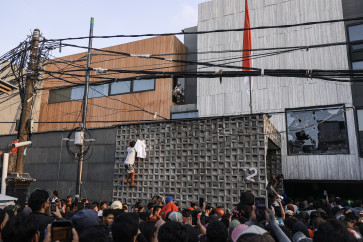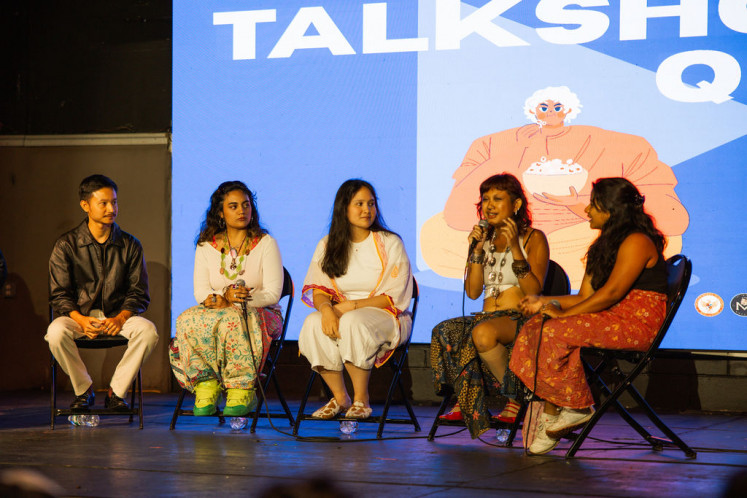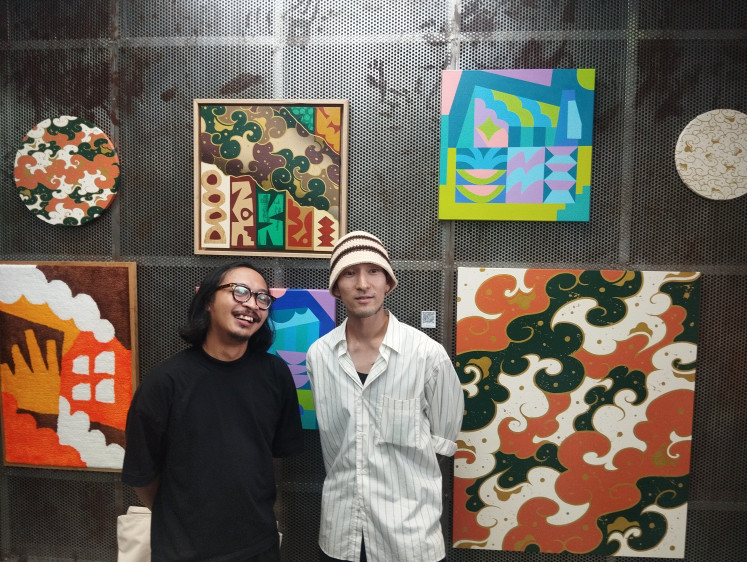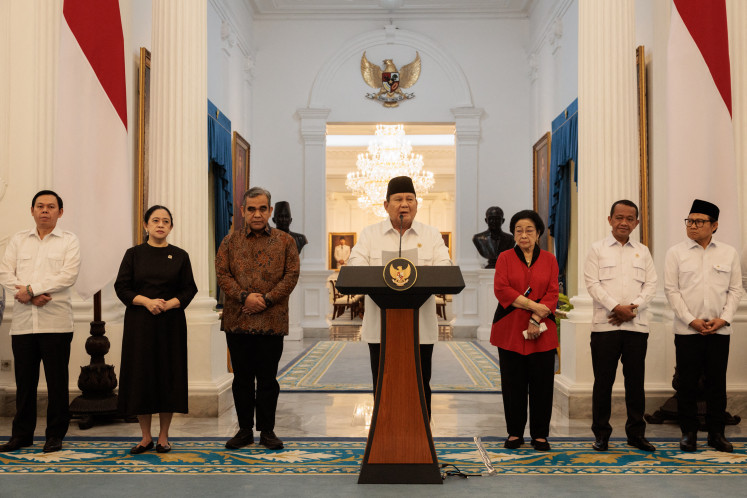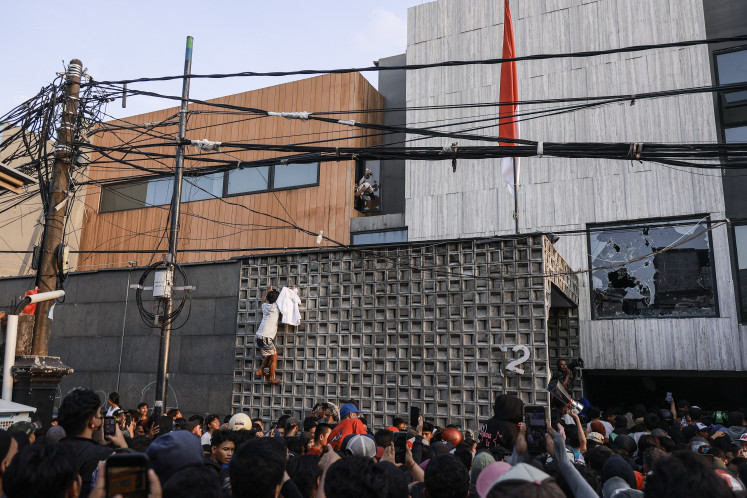Popular Reads
Top Results
Can't find what you're looking for?
View all search resultsPopular Reads
Top Results
Can't find what you're looking for?
View all search resultsLooking at the other side of batik
Despite the numerous efforts to introduce batik to the fashion world, many designers point out they have not been optimized to seize on “mass appeal” and ended up merely as collectible items.
Change text size
Gift Premium Articles
to Anyone
W
hile batik has steadily become staple wear for Indonesians at home, it’s still an uphill struggle for fabric and fashion designers to make an impression on the international market.
Despite the numerous efforts to introduce batik to the fashion world, many designers point out they have not been optimized to seize on “mass appeal” and ended up merely as collectible items.
“Foreign buyers don’t have the knowledge about batik, they can’t tell one motif apart from another. One piece of batik clothes or dress is enough for their wardrobe collection,” said designer R. Yuwono Widodo of Yoon label.
“Batik also has this image of traditional heritage and being old, which may not appeal to many people in this age and day. Plus, as batik is mostly made of silk or cotton, it’s not like batik is wearable for any occasion in a four-season country.”
According to Faramita Dewi, the designer of Amaragita Batik, Indonesian batik was still unrecognized overseas, with many fashion texts identifying batik motifs as “African” although they were actually Indonesian.
She referred to the attention garnered by British singer and actress Rita Ora several years ago when she wore a white suit from a major label bearing the signature megamendung motif of Cirebon batik, but there was no mention of its origins.
Another example is the hot sales made by Japanese mega-retailer Uniqlo with its “Batik Motif” collection that was distributed worldwide, using the parang (tongue of fire) and kawung (a four-lobed stylized flower) geometrical batik motifs.
“These facts show that the world loves the expressionist decorative motifs of our batik,” said Faramita.
In a bid to strengthen the presence of Indonesian batik on the world fashion map, both Faramita and Yuwono have experimented with batik by exploring not only the motifs but also the philosophy of Javanese heritage cloth through their creations.
YOON
In 2012, advertising employee Yuwono decided to leave his day job to be part of the booming batik industry at the time.
He initially tried to leverage his new position by exploring blue dyed batik Tuban on kain blacu (gray cloth) as his main material. But his first attempt failed.
“I couldn’t survive the tough competition among thousands of batik fashion producers unless I had extra capital or extra uniqueness,” he said.
He decided to go with the second option, and experiment with one particular element in Javanese culture: female dancers.
“I grew up in the old Javanese tradition and I believe the female dancers represent the strength of Javanese women that is hidden behind the traditional norms and values.”
(Read also: Local labels want young people to wear batik more often)
For his first collection, the “Dancer” series, he took the drawing of Javanese palace dancers from an old Dutch book that had belonged to his uncle and stylized it into different motifs to fit his designs for women’s wear for all ages.
In his other designs, he combined the dancers with the Japanese seigaha wave or the Balinese checkered motif poleng.
Yuwono added the description of the dance movement and the philosophy of it on each of his designs posted on his Facebook fan page Yoon Kla, the main display window for the sales.
For the second line, titled “Behind the Stage”, Yuwono was bolder with colors and the size of the picture — he used hand-painted pictures of dancers while the dancer is staring at her reflection, peeking behind the curtain, putting on make-up or chatting among themselves. His experimental works brought him to Hong Kong Fashion Week and the Who’s Next Prêt-à-Porter show in Paris last year that also opened his eyes about the foreign market for Indonesian ethnic wear.
“While enthusiasm is high in the local market because not much ethnic wear is wearable, the acceptance in the foreign market is lukewarm. There were many small boutiques in Europe that approached me, but it’s impossible to meet the cost of shipment with the low demand,” he said.
“We have to formulate what category is an Indonesian fashion product that appeals to the taste of the foreign market instead of being trapped in a trend that will last a few seasons. Otherwise, as we can see now how batik is a trend, it will at some point be saturated unless industry players keep rejuvenating the heritage tradition into something new.”
AMARAGITA BATIK
The label’s most recent collection, “Homecoming”, not only marked the return of designer Faramita from her studies in New York, but also was a turning point in reaching its goal to become the main source for Indonesian women to find edgy, modern batik while creating its own foreign market.
Faramita has not hesitated to boldly combine traditional batik techniques with futuristic motifs inspired by the Star Wars franchise on the staple fabrics of subtropical countries — wool and denim.
(Read also: Indonesian designers rock it out at New York Fashion Week)
The resulting 30 ready-to-wear pieces have a New Yorker look, with a monochromatic palate of gray, silver and denim — a contrast to its previous collections of colorful, formal batik dresses. She deconstructed her favorite kawung motifs to give them a simple and futuristic feel using either hand-drawn batik tulis techniques or stamped batik cap, or by integrating the motifs on the robot drawings.
“The traditional use of hot wax in making batik is only applicable to hot-resistant fabrics such as cotton, silk, rayon and linen. The wax-resist dying technique is also applicable to denim because the fabric is made of cotton fiber,” Faramita explained.
“For the wool fabric, the batik motifs are embellished from silk batik tulis pasted with embroidery applique techniques.”
The collection that was showcased at the recent Folk N Vogue — 100% Indonesia fashion exhibition comprises layered dresses, cropped tops combined with miniskirts, denim shirts with unique embroidered collars, as well as bomber jackets, trench coats and oversized jackets with a silhouette reflecting the name of the label, an ancient Javanese word that means feminine and elegant.
A new player in the industry, Amaragita has had a boutique in Bali since 2012 with another one to open in Surabaya. The label will soon have a flagship store in Greater Jakarta besides consignments in several department stores.
She identified the combination of heritage elements and contemporary graphic arts as the strong character of the batik motifs she designed.
“I aspire to enrich and to develop our batik motifs with the line art technique and doodling which are currently popular worldwide and integrate it with the heritage motifs to maintain the look of Indonesia,” she said.
“My intention is to bring in the philosophy of the modern motifs into the design just as each heritage motif has one, because that’s what batik is. A batik cloth carries a story, a meaning and, often times, wishes.”
Faramita plans to experiment with other fabrics, such as jersey made of natural fibers and cloth made of bamboo fiber, for her next collection.
“European countries have an interest in Indonesian traditional batik, but the American market prefers contemporary batik designs. By combining both characters, Amaragita looks forward to entering the two largest fashion markets.”



